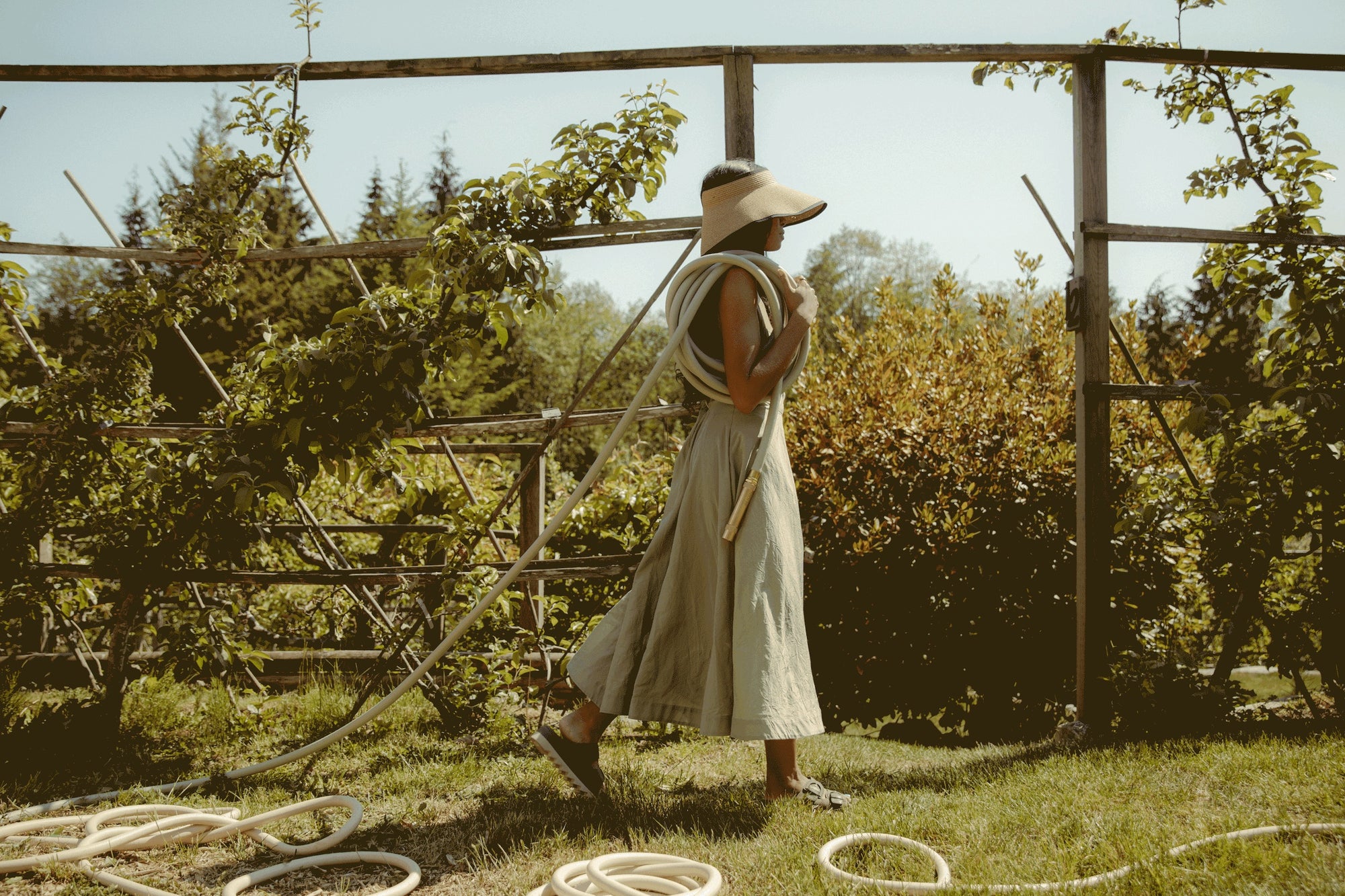Cultivating a garden is an exercise in curiosity, experimentation, patience, and wonder. Whether it’s a lush backyard refuge abundant with plants and flowers or a small windowsill collection of herbs, gardens of all kinds have boundless things to offer us.
And with the recent launch of our Everlasting Garden Hose, we’ve had gardening high on our minds. There’s an endless amount of beautiful gardens in the world, and we’ve been particularly inspired by those that have lasted, evolved, and shifted through time. A garden isn’t static, but ever-changing.

Below, take a look through a collection of inspiration images of gardens that have endured over time, and a way that we’re drawing inspiration from them for our own gardens, present and future.
1. TASHA TUDOR’S GARDEN
Bounty reigns in the gardens of Tasha Tudor, a legendary children’s book writer and illustrator, whose work included illustrating for Frances Hodgson Burnett’s The Secret Garden and Louisa May Alcott’s Little Women. Her New England garden feels bountiful and celebratory — the type of garden where you could spend hours among the flowers and lush grasses.
Prompt: A garden is inherently a place of abundance, and how can you bring this even more to the forefront? Consider doing away with straight lines and rows, and planting in clusters and bunches that flow freely and fill the space. How can you remove a sense of separation between plants, and create a feeling of plenty?

Tasha Tudor and her garden. Image Source: Pinterest
2. HANGING GARDENS OF BABYLON
Traveling deeper into the past, the infamous Hanging Gardens of Babylon feel like something out of a dream. The gardens themselves are a mystery even today, including exactly where they were located and the details of what they looked like — much is still uncertain. If the Hanging Gardens of Babylon existed at all, it would’ve likely been about 2500 years ago in Babylon, in modern day Iraq. Depictions include gardens with high stone walls, terraces, lush trees and herbs, with a complex watering system.
Prompt: Envisioning a garden with lush plants and terracing at different heights, how can you bring different dimensions and scales into your own gardening? Consider creating something that draws the eye at different heights to add a sense of dynamism and immersiveness.
3. GARDENS OF SIGIRIYA
In Sri Lanka, these gardens date back to the 5th century BC, making them some of the oldest landscaped gardens in the world. The gardens of Sigiriya are known for their ingenious water systems, which supply pools and fountains even today. A massive column of rock sits within the gardens, with pathways leading towards the ruins of a former fortress.
Prompt: Water soothes and restores us—being in it, listening to it, gazing at it. How can you use water features to bring in this same sense of peace and ease? Whether it’s a little bird bath or a small fountain, consider using water in your garden and the impact it could have on how your garden feels to be within.
4. ORTO BOTANICO DI PADOVA, ITALY
Lush plant life and fountains abound in these botanical gardens in Northern Italy, with the same original plot as the gardens originally had in 1545. The gardens were originally built for scientific reasons and to showcase medicinal botanicals, and today features thousands of different species.
Prompt: If you haven’t already, consider bringing in herbs into your garden. Try hardy lavender bushes for the soothing scent, grow mint to use in teas and cooking, or perhaps an herb you’ve never grown before. How can your garden become something restoring to you and those around you?
5. HAKONE OPEN AIR MUSEUM
In the mountainous town of Hakone, Japan, this sprawling space holds sculptures and pieces from Japanese and international artists. More outdoor museum than garden, the space brings together art and nature seamlessly, reminding us of the importance of setting and context.
Prompt: Consider how sculptural elements can impact a garden space. This could be a sculpture you love, or it could be any material that serves this purpose—perhaps a brick from a former project at home, a big rock you found and love. Remember that many objects can fill a sculptural purpose, without having to be sculptures themselves.
6. NOGUCHI MUSEUM GARDEN
“Everything is sculpture. Any material, any idea without hindrance born into space, I consider sculpture,” said sculptor Isamu Noguchi. This sentiment is easily seen in his sculpture gardens, whether at the Noguchi Museum in Queens, New York, or the Noguchi Garden Museum in his former studio in Mure, Japan. Here, you can see and appreciate his organic abstract forms, but also how other elements of the space are each valuable in and of itself.
Prompt: Remember context. Consider not just the main elements of the garden — whether that is a centrepiece or even your favourite flowers — but, how can you help those lesser thought parts of your garden still feel beautiful and thoughtful? Notice how each part of the space interacts with each other, and how you can help them all flow.




